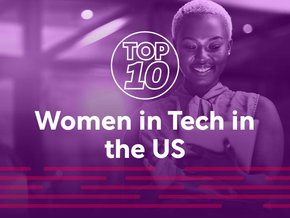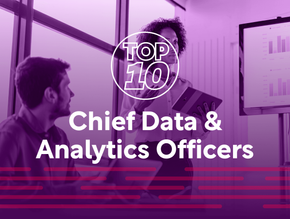Top 10: Technology trends for 2024

As the year comes to an end, the business landscape of 2024 will be reshaped by a potent confluence of disruptive forces. Generative AI's creative might and problem-solving prowess will unlock hidden efficiencies. Sustainability, no longer a buzzword, will morph into a strategic imperative, particularly when it comes to building AI models. And quantum computing, once science fiction, will crack open once-unimaginable possibilities.
Technology Magazine speaks to leading executives from tech companies to hear more about the main trends to look out for in 2024.
10: AI to take centre stage, moving from theory to practice
John Roese, Global Chief Technology Officer of Dell Technologies expects that the GenAI dialogue will move from theory to practice with shifts from training infrastructure and cost to inference and cost of operation.
“While GenAI has sparked incredibly creative ideas of how it will transform business and the world, there are very few real-world, scaled GenAI activities. As we move into 2024, we will see the first wave of GenAI enterprise projects reach levels of maturity that will expose important dimensions of GenAI not yet understood in the early phases,” he said.
9: A convergence of IT and security teams
As new threats emerge in 2024, blurring the lines between IT and security responsibilities, Zeki Turedi, CTO Europe at CrowdStrike, predicts that there will be an opportunity to enhance organisational resilience by converging IT and security teams within enterprises.
“Traditionally operating in separate silos, these teams are finding their objectives and daily operations increasingly intertwined. This shift is driven not only by the rapid advancement of technology but also by the evolving landscape of security risks that directly impact IT infrastructure.
“This convergence is particularly timely and necessary as singular threats now simultaneously target both infrastructure and security, demanding a unified response. By fostering closer collaboration, sharing technologies and platforms, these once-disparate teams can combine their expertise to bolster defences against sophisticated cyber threats. The advent of new cybersecurity platforms, tailored specifically for IT teams, is a testament to this trend. These platforms are designed to seamlessly integrate with IT operations, providing real-time insights and automated responses to security incidents, thereby reducing the response time and enhancing overall security posture.”
8: Hyperscalers will drive a powerful, real-time ecosystem
Generative AI has often been criticised for tapping into old data to drive mission-critical results. However, SambaNova Systems’ CEO, Rodrigo Liang, predicts that the collaboration between hyperscalers and AI models will revolutionise the entire data analytics landscape, matching current data with real-time fine tuning, leading to significant speed, accuracy and price improvements.
“We’ll continue to see a shift towards real-time fine-tuning, allowing models to adapt and understand current data, thus driving advancements in AI applications in every industry,” he says. “The combination of advanced chips and hyperscale data capabilities will create a powerful ecosystem, enabling the development of very large Composition of Experts models to address even more complex use cases than what we’ve even come close to seeing today in industries like marketing, advertising, healthcare, climate, banking and more.”
7: A renewed focus on zero trust models
In today’s hybrid work environment, people rely on more devices, apps, and services than ever, many of them hosted in the cloud on systems that are physically outside the control of corporate IT. This new landscape requires a zero-trust model.
In the coming year, Chris Peake, CISO and SVP of Security at Smartsheet, predicts that we’ll see organisations add extra layers to their models.
“For example, some organisations might add role-based security, allowing them to define roles for different types of users and manage their access accordingly,” he says. “This will enable them to protect sensitive information while reducing the barriers to access for authorised individuals. Organisations may also add time-based access, allowing them to manage users’ access to information based on the length of the project they’re working on.
“Additionally, Generative AI has huge potential to strengthen data security and add an extra layer of protection. Nobody can manually monitor all the data flowing through their business; intelligent systems need to take on that burden. Machine learning can grow to “understand” what’s normal and flag anything that isn’t.”
6: IT spend will be focused on business outcomes more than ever
Faced with an evolving macro-economic and competitive landscape, Linda Yao, Chief Operating Officer and Head of Strategy, Lenovo Solutions & Services Group, predicts that businesses will be focused on deriving more value from their IT spending in a couple of ways.
“The first is they will demand more flexibility in their operations, in terms of having their investments scale with the value they return,” she says. “They will want more predictability in their cash flows, whether that means using technology to stabilise revenue growth or to achieve expense savings, or implementing that technology in a way that allows for predictable cash flow payments.
“Businesses will also be focused on ensuring IT deployment directly supports or drives business outcomes. We will see more customers adopt IT based on business outcomes that they want to achieve whether it’s top line, bottom line, or to hit specific customer experience, sustainability, throughput, customer acquisition, type of metrics. More businesses will tie their technology adoption to these metrics rather than deploy and maintain technology in a vacuum.
“As a result, IT spending on legacy infrastructure will shift to spending on next generation technology and grow rapidly in the next five to 10 years as customers modernise or revamp their IT stack end to end. This includes moving from legacy IT systems to hybrid cloud, adopting more virtualised and interconnected IT environments and eschewing traditional software licences for highly personalised tech on demand.”
5: Quantum progress but not quantum leaps
According to Liz Centoni, Executive Vice President Chief Strategy Officer & GM, Applications at Cisco, in 2024 we will see adoption of post-quantum cryptography (PQC) – even before it is standardised – as a software-based approach that works with conventional systems to protect data from future quantum attacks.
“PQC will be adopted by browsers, operating systems, and libraries, and innovators will experiment by integrating it into protocols such as SSL/TLS 1.3 which governs classic cryptography. PQC will also start to trickle down to enterprises as they aim to ensure data security in the post-quantum world.
“Another trend will be the growing importance of quantum networking which in four or five years – perhaps more – will enable quantum computers to communicate and collaborate for more scalable quantum solutions. Quantum networking will leverage quantum phenomena such as entanglement and superposition to transmit information. QKD as an alternative or a complement to PQC depending on the level of security and performance required, will also leverage quantum networking. Quantum networking will see significant new research and investment by government and financial services which have high demands for data security and processing.”
4: Human skills will be essential for the uptake of AI
NTT’s 2023 Global CX Report found that the majority of CX interactions still require a form of human intervention, with executives agreeing that this will remain a critical part of customer journeys. Despite four in five organisations planning to incorporate AI into CX delivery within the next 12 months, Sashen Naidu, Vice President, CX Services at NTT Ltd explains that the human element will be central to its success.
“As enterprises turn their attention to how automation can complement and enhance human capabilities, they will place greater emphasis on closing the mounting skills shortages that will challenge AI aspirations. The fundamentals of AI and big data analytics will become baseline skills for a majority of jobs across industries, but new hires won’t be the only pathway.
“Research by NTT DATA uncovered that business leaders are more likely to have seen profitability of more than 25% over the last three years because of investments in reskilling and upskilling initiatives. This will continue into 2024, with more curated teaching experiences to help close skills gaps and meet the needs of organisations.”
3: Continued rise of social engineering attacks
According to Crowdstrike’s Turedi, identity based attacks will continue to be the main weapon for threat actors in 2024, for the simple reason that it continues to be a very fruitful method.
“As revealed in CrowdStrike’s latest Threat Hunting Report, 80% of breaches occur through compromised identities. Adversaries are not relying solely on compromised valid credentials, either — rather, they abused all forms of identification and authorization, including weak credentials purchases from the underground, and they elevated their phishing and social engineering tradecraft.
“Social engineering is the highlight here, as businesses strive to educate their employees about the common ways to recognise they are being deceived. This makes identity protection the most critical protection that companies should look to strengthen in 2024. Otherwise, adversaries will continually target this weak spot - and they will be successful more often than not.”
2: AI advancements will drive even more energy usage
As Cisco’s Centoni explains, sustainable energy plays a vital role in addressing climate change. Selecting smaller AI models with fewer layers and filters specific to use cases, companies will begin to reduce energy consumption costs compared to general systems.
“These dedicated systems are trained on smaller, highly accurate data sets and efficiently accomplish specific tasks. In contrast, deep learning models use vast amounts of data.
“The fast-emerging category of energy networking, which combines the capabilities of software-defined networking and an electric power system made up of direct-current micro grids, will also contribute to energy efficiency. Applying networking to power and connecting it with data, energy networking offers comprehensive visibility and benchmarking of existing emissions and an access point for optimising power usage, distribution, transmission, and storage. Energy networking will also help organisations measure energy usage and emissions more accurately, automate many functions across IT, smart buildings, and IoT sensors, and unlock inefficient and unused energy. With embedded energy management capabilities, the network will become a control plane for measuring, monitoring, and managing consumption.”
1: Businesses will focus on creating guardrails to mitigate AI risks
According to Art Hu, SVP & Chief Information Officer at Lenovo, companies deploying AI will become more cognisant about the risks and underlying nature of AI, with more businesses set to take targeted actions to mitigate this.
“For example, new patterns such as Retrieval Augmented Generation can help LLMs generate results from authoritative sources,” he says. “Additional techniques such as ensuring the quality and fidelity of training data and keeping a human in the loop for both training (reinforcement learning based on human feedback), and inference for the most sensitive scenarios are ways of balancing the augmented intelligence that Generative AI provides.
“We will also see an increase in robust governance policies, processes and tools including testing and validation for AI generated content, embedding monitoring throughout the entire system. Having a clear AI policy that lays out the criteria to determine what is ethical, responsible, and inclusive will guide the use of AI. This coupled with education so that teams working in this space can learn the skills necessary to implement the guidance, will be the cornerstone from which we will see businesses executing tangible AI plans.”
******
Make sure you check out the latest edition of Technology Magazine and also sign up to our global conference series - Tech & AI LIVE 2024
******
Technology Magazine is a BizClik brand
- Microsoft & Alphabet: AI and Cloud Strategy Driving SuccessIT Procurement
- Dell Technologies: Firms Expect AI to Transform IndustriesAI & Machine Learning
- Coca-Cola & Microsoft Partner to Accelerate Cloud and Gen AICloud & Cybersecurity
- Microsoft, AWS & Oracle: Why Big Tech is Investing in JapanDigital Transformation






